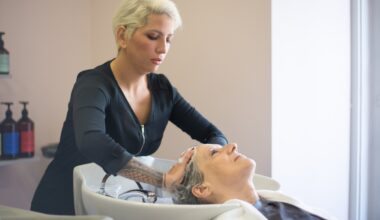Introduction
Hair is a crowning glory, an essential part of our personality. And while the winds of hair fashion change frequently, straight, glossy locks never go out of style. Over the years, a myriad of products—straightening creams, gels, and essential oils—have claimed the spotlight, offering promises of sleek, straight hair. But with the ever-present demand comes the inevitable question: Are these products truly safe for our beloved tresses and scalp? Let’s embark on a journey to understand the intricacies of hair straightening solutions.
Are Hair Straightening Creams Safe?
Hair straightening creams, like all cosmetic products, come with a spectrum of safety profiles. While some creams use milder, hair-friendly ingredients, others may contain stronger chemicals that provide longer-lasting results but can pose potential risks.
- Ingredients to Watch Out For: Formaldehyde, a potent straightening agent, has been linked to health issues when used in excess or without proper safety precautions. Similarly, some creams might contain high levels of sulfates or parabens, which some users prefer to avoid due to potential allergic reactions.
- Skin Sensitivity: It’s crucial to understand your skin and hair type. Always perform a patch test 48 hours before full application to prevent severe allergic reactions or chemical burns.
- Professional Guidance: Sometimes, the best approach is seeking advice from a trusted hair professional who can recommend suitable products for your hair type and condition.
Hair Straightening Gel vs. Cream: Choosing the Right Option
In the expansive world of hair straightening, gels and creams often stand side by side, each with its legion of loyalists.
- Gels: Known for their lightweight consistency, gels do not weigh the hair down, making them a popular choice for those with finer hair. They offer a short-term effect, ideal for daily or occasional straightening.
- Creams: Richer in consistency, creams offer deep conditioning and longer-lasting straightness. They’re often the go-to for those with thicker, coarser hair seeking more persistent results.
- Application Techniques: While gels are typically applied to damp hair and then styled, creams might require application on dry hair, followed by the use of a straightener to lock in the effect.
The Quest for Smoothness: Exploring Hair Smoothing Creams
Beyond the realm of straightening lies the desire for smooth, frizz-free hair. Enter hair smoothing creams, the saviors for those who battle daily with unruly tresses.
- Benefits: Unlike straightening products that alter hair structure, smoothing creams work by sealing moisture, combating humidity, and taming flyaways.
- Popular Choices: Brands like Kerastase, Living Proof, and Moroccanoil have garnered attention for their effective smoothing creams.
- Usage Tips: For best results, apply to damp hair, focusing on the lengths and ends. Pair with a wide-tooth comb for even distribution.
Harnessing the Power of Essential Oils for Hair Straightening
Essential oils, those potent botanical extracts, have been celebrated for their therapeutic properties for centuries. But their role in the world of hair care, especially in the domain of hair straightening, remains intriguingly less explored.
- Natural Straightening Oils: Some essential oils, like lavender and rosemary, help in relaxing the natural wave of hair. They don’t offer the same drastic effects as chemical treatments but contribute to a smoother texture with regular use.
- Benefits: Apart from their straightening ability, these oils also nourish the scalp, promote hair growth, and add a natural sheen to your tresses.
- Usage: Mix a few drops of the chosen essential oil with a carrier oil (like coconut or jojoba). Apply the blend to your hair, leaving it on for a few hours or overnight for best results.
Keratin Creams for Hair Straightening
When it comes to straightening, keratin is the buzzword. Originating from our hair’s natural protein, keratin treatments and creams have taken the hair world by storm.
- How it Works: Keratin creams work by replenishing the hair’s natural protein, filling in the gaps or porous areas and smoothing the hair shaft.
- Effectiveness: The results can be startling – shinier, straighter hair that lasts for weeks or even months.
- Safety Considerations: It’s vital to note that not all keratin treatments are created equal. Some might contain formaldehyde or its derivatives. Ensure you’re well-informed about the ingredients and potential risks.
Safety Tips for Using Hair Straightening Creams
Safety should never be an afterthought when it comes to treatments that alter our hair’s natural structure.
- Follow Instructions: Overlooking the guidelines can lead to overprocessing, causing hair breakage or scalp issues.
- Avoid Overuse: Continuous, repetitive use of straightening products can weaken the hair shaft, leading to long-term damage.
- Look Out for Signs: Itching, burning, or any unusual sensation should be a signal to rinse the product off immediately.
Best Practices for Hair Straightening with Creams, Gels, and Oils
To get the most out of your straightening regimen and ensure the health of your hair, consider the following steps:
- Preparation: Before any treatment, ensure your hair is clean and free from build-ups. This enhances the product’s effectiveness.
- Heat Protection: If you’re coupling your products with heat styling, always use a heat protectant.
- Maintenance: Post straightening, invest in a good conditioner or hair mask to ensure your hair remains hydrated and healthy.
Conclusion
Hair straightening products, whether it’s creams, gels, or essential oils, promise the allure of sleek, straight hair. But as with all things beauty, it’s crucial to prioritize safety and knowledge. Here’s to making informed decisions and flaunting those glossy, straight locks with confidence.






